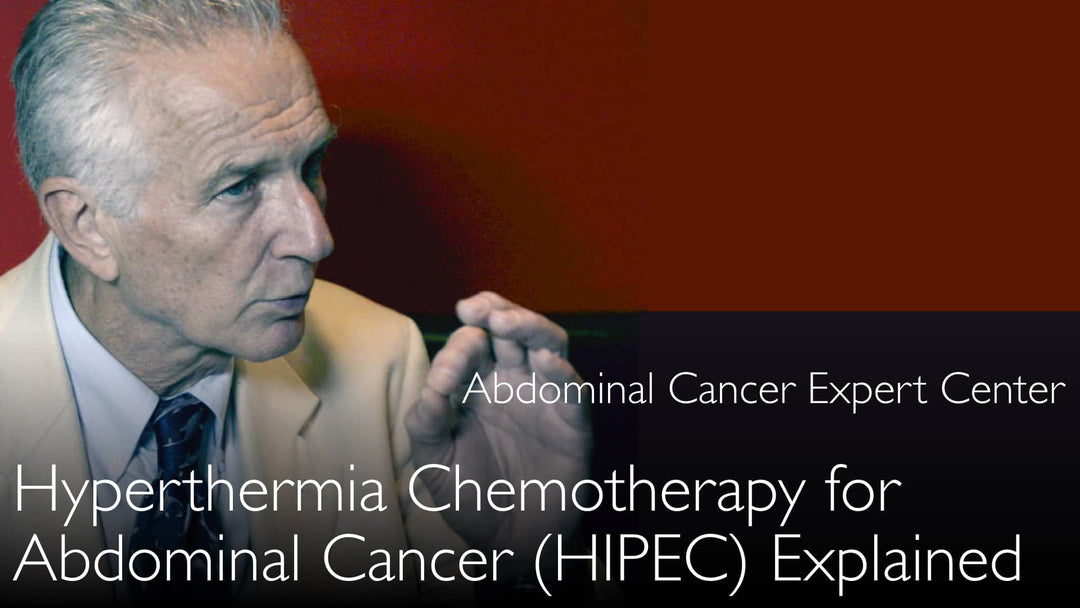Leading expert in peritoneal cancer treatment, Dr. Paul Sugarbaker, MD, explains the critical role of hyperthermia in HIPEC therapy. He details how heat increases chemotherapy penetration and cytotoxicity against cancer cells. Dr. Paul Sugarbaker, MD, discusses the technical aspects of maintaining optimal temperatures during the procedure. He emphasizes the need for personalized chemotherapy selection based on molecular markers, not just tumor location. The interview highlights that cytoreductive surgery provides 90% of the treatment benefit, with HIPEC contributing the remaining 10%.
Hyperthermic Intraperitoneal Chemotherapy (HIPEC): Mechanism and Efficacy for Peritoneal Metastases
Jump To Section
- Why Heat Enhances Chemotherapy Efficacy
- Optimal HIPEC Temperatures and Delivery
- Selecting Chemotherapy Agents for HIPEC
- The Need for a Precision Medicine Approach
- Surgery vs. HIPEC: Relative Importance in Treatment
- Full Transcript
Why Heat Enhances Chemotherapy Efficacy
Dr. Paul Sugarbaker, MD, a renowned gastrointestinal cancer surgeon, explains the three primary mechanisms by which hyperthermia improves chemotherapy for peritoneal metastases. Heat significantly increases the penetration of chemotherapy drugs into abdominal tissues. This deeper tissue penetration allows the medication to reach more cancer cells.
Hyperthermia also directly increases the cytotoxicity of the chemotherapy medications used. The drugs become more effective at killing cancer cells when administered at elevated temperatures compared to normal body temperature. Dr. Paul Sugarbaker, MD, notes that heat itself is an effective treatment for some cancers. An additional physiologic benefit is that the procedure helps rewarm a patient whose body temperature has dropped during lengthy cytoreductive surgery.
Optimal HIPEC Temperatures and Delivery
The target temperature for effective Hyperthermic Intraperitoneal Chemotherapy is between 42 and 43 degrees Celsius throughout the abdominal cavity. Modern HIPEC delivery uses a sophisticated recirculation system to achieve and maintain this temperature. A pump circulates the chemotherapy solution into the patient's peritoneal space.
The solution is then drawn out, passed through a heating coil, and pumped back in. Dr. Paul Sugarbaker, MD, describes how the solution enters the abdomen at 44-45 degrees Celsius. It is distributed manually by the surgeon or by gently moving the patient. The solution cools to the ideal 42-43 degrees within the peritoneal space and exits through drains at approximately 39 degrees before being reheated and recirculated.
Selecting Chemotherapy Agents for HIPEC
Dr. Paul Sugarbaker, MD, identifies chemotherapy selection as a critical area needing advancement in HIPEC treatment. Current practice often relies on the anatomic origin of the cancer. For colorectal cancer metastases, the common agents are mitomycin C or a combination of mitomycin C and doxorubicin.
This anatomical approach is suboptimal. Dr. Paul Sugarbaker, MD, states that mitomycin C may only benefit about 50% of patients. This means half of all patients undergoing the intense HIPEC procedure receive a chemotherapy wash that is ineffective for their specific cancer. This highlights a significant limitation of a one-size-fits-all chemotherapeutic strategy.
The Need for a Precision Medicine Approach
Dr. Anton Titov, MD, and Dr. Paul Sugarbaker, MD, discuss the urgent need to move beyond anatomical classification. The future of HIPEC lies in personalized medicine based on the molecular markers of a patient's tumor. This shift is essential for improving response rates.
Dr. Sugarbaker advocates for using multiple chemotherapy agents, both intraperitoneally and intravenously. Systemically administered drugs are augmented by the abdominal heat as they circulate. This combination approach aims to achieve a maximal response against the peritoneal metastases during the critical 90-minute HIPEC window.
Surgery vs. HIPEC: Relative Importance in Treatment
The Sugarbaker Procedure is a two-part treatment combining cytoreductive surgery and HIPEC. Dr. Paul Sugarbaker, MD, is unequivocal about which component provides the greatest benefit to the patient. He estimates that 90% of the treatment's success is attributable to the surgical effort.
The precision surgery, involving peritonectomy and visceral resection, is the cornerstone of therapy. The Hyperthermic Intraperitoneal Chemotherapy component contributes the remaining 10% of the therapeutic benefit. This underscores that HIPEC is a powerful adjuvant to meticulous surgery, not a standalone treatment for advanced peritoneal surface malignancies.
Full Transcript
Dr. Anton Titov, MD: Renowned Harvard-trained American cancer surgeon discusses heated chemotherapy or "hot chemo bath" cancer treatment. Hot chemo bath is part of the Sugarbaker Procedure, which consists of cytoreductive surgery and Hyperthermic Intraperitoneal Chemotherapy (HIPEC). What makes hyperthermic heated chemotherapy particularly effective in metastatic peritoneal cancers? How to select chemotherapy medications that are used in heated chemotherapy? "Hot chemo bath" heated chemotherapy efficacy explained.
Hyperthermic Intraperitoneal Chemotherapy (HIPEC), hot chemo bath, heated chemotherapy is treatment for colon cancer, gastric cancer, ovarian cancer. They spread in the abdomen and peritoneal cavity. Peritoneal metastases in advanced stage 4 colon cancer treatment by cytoreductive surgery and Hyperthermic Intraperitoneal Chemotherapy (HIPEC) [hot chemo bath, heated chemotherapy]. Medical second opinion clarifies colon cancer or ovarian cancer diagnosis.
Medical second opinion confirms that cure is possible in metastatic colon cancer. Intraperitoneal chemotherapy treatment for advanced stage 4 cancer with metastatic lesions in the abdomen. Medical second opinion helps to select a precision medicine treatment for stage 4 ovarian cancer or stage 4 colon cancer or metastatic stage 4 gastric cancer. Get medical second opinion on advanced cancer with peritoneal metastases.
Best peritoneal metastatic advanced cancer treatment by surgical operation and regional chemotherapy. Video interview with Dr. Paul Sugarbaker, leading expert in peritoneal metastatic cancer treatment (cytoreductive surgery and Hyperthermic Intraperitoneal Chemotherapy (HIPEC), hot chemo bath, heated chemotherapy. Peritoneal metastases from colon cancer, ovarian cancer, and other gastrointestinal cancers are treated by Sugarbaker Procedure.
Dr. Anton Titov, MD: One part of procedure is resection of peritoneal metastases. Another part of the Sugarbaker Procedure involves Hyperthermic Intraperitoneal Chemotherapy (HIPEC). It is hot chemo bath, heated chemotherapy.
Dr. Anton Titov, MD: Please talk more about hyperthermia part of Hyperthermic Intraperitoneal Chemotherapy (HIPEC).
Dr. Anton Titov, MD: Why increasing the temperature of chemotherapy is important for peritoneal metastases cancer therapy?
Dr. Paul Sugarbaker, MD: Hyperthermia has been shown in animal laboratory and in humans to increase the penetration of the chemotherapy into normal tissues. The chemotherapy gets deeper into the tissues when it is applied with heat. We know that.
Secondly, the chemotherapy medications that we use have increased cytotoxicity when applied as part of Hyperthermic Intraperitoneal Chemotherapy (HIPEC). In other words, hyperthermic chemotherapy solutions have increased killing of the cancer cells when they are used with heat. Hyperthermic chemotherapy medications work better than when they are used at normal body temperature. That has been very well demonstrated.
The third aspect of it is this. Heat in and of itself is an effective treatment of some cancers. Hot chemo bath, heated chemotherapy. There are other reasons for using the Hyperthermic Intraperitoneal Chemotherapy (HIPEC).
For example, it took six hours for surgery to resect peritoneal cancer metastases and finish a cytoreductive procedure. The patient's abdomen has been open to the air for a long time. Patients tend to become cold during the surgical operation. Patient's body temperature decreases to 35 or even 34 degrees Celsius.
The anesthesiologists are managing all the vital signs and the blood coagulation. They are very happy that now the patient is going to come back up to normal body temperature. Applying Hyperthermic Intraperitoneal Chemotherapy (HIPEC) is actually a very physiologic thing to do.
Dr. Anton Titov, MD: What kind of temperatures of chemotherapy solution are we talking about? [hot chemo bath, heated chemotherapy.]
Dr. Paul Sugarbaker, MD: For Hyperthermic Intraperitoneal Chemotherapy (HIPEC) procedure we like to have 42-43 degrees centigrade within the whole abdomen.
Dr. Anton Titov, MD: How is the solution of chemotherapy heated? Is chemotherapy solution preheated, then applied as a hot solution?
Dr. Paul Sugarbaker, MD: Most of the modern HIPEC machines involve a recirculation. There is a pump that pumps the chemotherapy into the patient's peritoneal space in the abdomen. Then the chemotherapy is drawn out. Chemotherapy solution goes through a heating apparatus, usually a coil. Then chemotherapy is pumped back into the patient.
It is a continuous flow of chemotherapy solution. It goes in warm at 44-45 degrees. It is distributed around the patient's abdomen. Heated chemotherapy solution can be distributed around the peritoneal space by moving the patient's abdomen or by the surgeon's double-gloved hand.
Sometimes we are moving the chemotherapy solution around the abdomen; it almost immediately cools down to the 42-43 degrees. [hot chemo bath, heated chemotherapy]. Then intraperitoneal chemotherapy solution comes out at the other side through the drains at about 39 degrees. Sometimes chemotherapy to treat peritoneal cancer metastases comes around; it just recirculates again into the patient's abdomen.
Dr. Anton Titov, MD: Selection of the chemotherapeutic medication for Hyperthermic Intraperitoneal Chemotherapy (HIPEC) depends on the type of cancer? Is there a preferred chemotherapeutic medication that you use in the Sugarbaker procedure?
Dr. Paul Sugarbaker, MD: I would say that choosing the correct chemotherapy medication requires the most work at this point in time. We need to work more on the selection of the optimal chemotherapy agent for a particular patient. As you know, at this point in time we tend to choose cancer treatment medications based on the anatomic location of the cancer.
For colorectal cancer we usually use mitomycin C or mitomycin C and doxorubicin. But is that the best chemotherapy medication for a particular patient? It probably is not.
Dr. Anton Titov, MD: This is a continuous topic of discussion that I had with a lot of oncologists. The goal is to move from anatomical classification of tumors and into the molecular markers in the tumor and in the patient.
Dr. Paul Sugarbaker, MD: We have to use personalized medicine for the patient to select chemotherapy, not just the anatomical classification of cancers. That seems to be what you are talking about.
Absolutely. It is distressing that we know that using mitomycin C maybe helps 50% of the patients. Only half of cancer patients are going to respond to that chemotherapy medication, even though it is heated during Hyperthermic Intraperitoneal Chemotherapy (HIPEC) treatment. A lot of peritoneal metastatic cancer patients will not benefit from this chemotherapy medication. All patients are getting is 90 minute washing of their abdomen.
Dr. Anton Titov, MD: Only 50% of patients benefit from this chemotherapy medication during Hyperthermic Intraperitoneal Chemotherapy (HIPEC)? That is a toss of a coin?
Dr. Paul Sugarbaker, MD: That's correct! That's correct! We now need to begin using multiple chemotherapy agents for Hyperthermic Intraperitoneal Chemotherapy (HIPEC) to treat abdominal cancer metastases.
Medications given into the peritoneal space that are augmented by heat. We have to use chemotherapy medications that are given in the bloodstream; these are augmented by heat. Because these chemotherapy medications will circulate to the abdominal organs. Chemotherapy to treat peritoneal metastatic cancer will be augmented by the heat within the peritoneal space during Hyperthermic Intraperitoneal Chemotherapy (HIPEC).
We need now to be thinking about a combination of intravenous and intraperitoneal chemotherapy agents to get a maximal response from peritoneal cancer tumor. Because we have 90 minutes to treat peritoneal metastatic cancer during Hyperthermic Intraperitoneal Chemotherapy (HIPEC). We have to be very accurate in what we're doing.
Sometimes we do not select chemotherapy medications correctly. A lot of patients are going to be treated with chemotherapy and not benefit from cancer treatment. Luckily, probably the most meaningful treatment method of all aspects of Hyperthermic Intraperitoneal Chemotherapy (HIPEC) is surgery.
It is the peritonectomy and the visceral resection that is the most important part of Hyperthermic Intraperitoneal Chemotherapy (HIPEC). I would say 90% of it is in the surgical part of peritoneal cancer treatment. 10% of benefit for patients is in the Hyperthermic Intraperitoneal Chemotherapy (HIPEC) [hot chemo bath, heated chemotherapy].
Dr. Anton Titov, MD: It is a combination of precision medicine and precision surgery to treat peritoneal metastases from colorectal cancer, ovarian cancer or gastric cancer?
Dr. Paul Sugarbaker, MD: Absolutely, yes. [hot chemo bath, heated chemotherapy]. "Hot chemo bath" heated chemotherapy efficacy explained by leading peritoneal cancer surgeon.
Dr. Anton Titov, MD: Hyperthermic Intraperitoneal Chemotherapy HIPEC for stage 4 cancer.





